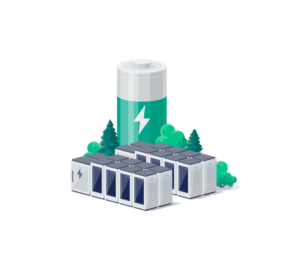Battery Energy Storage Systems (BESS)
Operation and Key Applications
Battery Energy Storage Systems (BESS) play a strategic role in the energy transition.
While batteries are often associated with electric vehicles, their application goes far beyond mobility. BESS refers to stationary systems capable of storing electricity at scale, especially from renewable energy sources.
In practice, these systems store electricity — whether sourced from solar, wind, or conventional generation — in rechargeable batteries, then release it on demand.
What is a BESS and how does it work?
Technically speaking, a battery operates using direct current (DC). Energy is stored in electrochemical form and, when required — to balance the grid, cover a consumption peak, or power a site during a disconnection — the system releases the stored energy, converting it into alternating current (AC) to power equipment or feed the grid.
This ability to “absorb” or “release” energy on demand lies at the heart of energy flexibility. It helps mitigate the intermittency of renewables, optimize consumption based on market prices, and secure sites against outages.
Inside a BESS: Core Technical Components
A battery storage system is far more than just “batteries in a box.” It's a structured ecosystem of interconnected components, designed to ensure not only energy storage, but also its conversion, intelligent management, safety, and grid integration. Here's a look at the core elements:
🔋 Battery Cells and Modules
The system’s core is made up of electrochemical cells, converting chemical energy to electricity and vice versa. These cells are grouped into modules, then into racks, depending on the desired energy capacity (kWh) and power (kW to MW).
Batteries are connected in series and parallel to reach the required voltage and capacity levels. They generally come in two formats:
- Technical cabinets (for small to medium systems),
- Standard containers (20 or 40 feet) for high-capacity installations.
🧊 Storage Enclosure and Thermal Management
Batteries are housed in secure enclosures — racks or containers — that include thermal management systems: HVAC, forced ventilation, or active cooling/heating solutions. Maintaining a stable temperature is essential to ensure performance, lifespan, and safety.
🧠 Battery Management System (BMS)
The BMS monitors and controls each battery module. It tracks in real time:
- Voltage, current, and temperature of every cell,
- State of Charge (State of Charge, SoC),
- State of Health (SoH).
It acts as a local supervisor, ensuring the system operates within safe parameters — preventing overcharge, deep discharge, or thermal drift.
🔄 Inverter / Power Conversion System (PCS)
Since batteries operate in DC, the energy must be converted to AC to be compatible with the grid or site usage. The PCS handles this conversion.
Bidirectional inverters allow both charging and discharging, enabling flexible energy control based on grid signals or internal site logic.
🧩 Energy Management System (EMS)
The EMS is the central brain of the installation. It coordinates all subsystems (BMS, PCS, sensors, communication) and optimizes:
- Energy flow management (charge/discharge),
- Response to grid signals or market prices,
- Site energy priorities (self-consumption, backup, load shifting, etc.).
Advanced EMS can integrate AI or machine learning, enabling predictive control based on demand forecasts and market behavior.
🚨 Integrated Safety Systems
Risk management is critical in BESS infrastructure. Beyond standard electrical protections, safety systems include:
- Smoke detection,
- Fire suppression (inert gas, aerosol, etc.),
- Temperature and gas sensors,
- Physical access control, video surveillance, and remote supervision.
These are coordinated via a dedicated monitoring and safety platform, ensuring secure operations under all conditions.
Applications and Benefits of Battery Storage Systems
BESS provides strategic advantages for modern energy management by reinforcing flexibility, resilience, and efficiency across power systems. Their deployment responds to operational, economic, and technical challenges — particularly in industrial and commercial sectors.
⚡ Energy Optimization and Cost Reduction
- Peak shaving: reduces demand charges by lowering power peaks.
- Load shifting: stores energy when prices are low, uses it when prices spike.
- Grid independence: provides backup power in case of outages or extreme weather events.
🔁 Grid Flexibility and System Services
- Demand response: adjusts consumption based on market or grid operator signals.
- Grid stabilization: fast response (<150 ms) for frequency and voltage control — preventing imbalances and blackouts.
☀️ Renewable Integration
- Intermittency smoothing: stores surplus solar or wind power and releases it when needed.
- “Always on” supply: ensures energy availability even when the sun doesn’t shine or the wind doesn’t blow.
Conclusion
Battery energy storage systems are no longer optional — they are now a cornerstone of modern energy architecture. BESS brings the flexibility, stability, and autonomy needed to handle the challenges of fluctuating demand and intermittent renewable production. In today’s energy landscape, deploying BESS is not just a strategic decision. It’s a technical imperative for ensuring reliability and performance across infrastructures.


